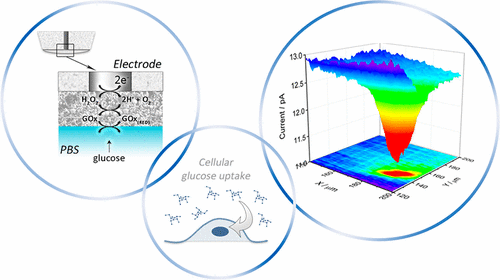Our official English website, www.x-mol.net, welcomes your
feedback! (Note: you will need to create a separate account there.)
Glucose and Lactate Miniaturized Biosensors for SECM-Based High-Spatial Resolution Analysis: A Comparative Study
ACS Sensors ( IF 8.2 ) Pub Date : 2017-08-24 00:00:00 , DOI: 10.1021/acssensors.7b00324 Alice Soldà 1, 2 , Giovanni Valenti 1 , Massimo Marcaccio 1 , Marco Giorgio 2 , Pier Giuseppe Pelicci 2 , Francesco Paolucci 1 , Stefania Rapino 1, 2
ACS Sensors ( IF 8.2 ) Pub Date : 2017-08-24 00:00:00 , DOI: 10.1021/acssensors.7b00324 Alice Soldà 1, 2 , Giovanni Valenti 1 , Massimo Marcaccio 1 , Marco Giorgio 2 , Pier Giuseppe Pelicci 2 , Francesco Paolucci 1 , Stefania Rapino 1, 2
Affiliation

|
With the aim of developing miniaturized enzymatic biosensors suitable for in vitro diagnostic applications, such as monitoring of metabolites at single cell level, glucose and lactate biosensors were fabricated by immobilizing enzymes (glucose oxidase and lactate oxidase, respectively) on 10 μm Pt ultramicroelectrodes. These electrodes are meant to be employed as probes for scanning electrochemical microscopy (SECM), which is a unique technique for high-spatial-resolution electrochemical-based analysis. The use of enzymatic moieties improves sensitivity, time scale response, and information content of the microprobes; however, protein immobilization is a key step in the biosensor preparation that greatly affects the overall performance. A crucial aspect is the miniaturization of the sensing, preserving their sensitivity. In this work, we investigated the most common enzyme immobilization techniques. Several fabrication routes are reported and the main figures of merit, such as sensitivity, detection limit, response time, reproducibility, spatial resolution, biosensor efficiency, permeability, selectivity, and the ability to block electro-active interfering species, are investigated and compared. With the intent of using the microprobes for in vitro functional imaging of single living cells, we carefully evaluate the spatial resolution achieved by our modified electrodes on 2D SECM imaging. Metabolic activity of single MCF10A cells were obtained by monitoring the glucose concentrations in close proximity of single living cell, using the UME-based biosensor probes prepared. A voltage-switch approach was implemented to disentangle the topographical contribution of the cells enabling quantitative measurements of cellular uptakes.
中文翻译:

葡萄糖和乳酸微型生物传感器用于基于SECM的高空间分辨率分析:对比研究
为了开发适用于体外的小型化酶生物传感器通过将酶(分别为葡萄糖氧化酶和乳酸氧化酶)固定在10μmPt超微电极上,可以制造诊断应用程序,例如监测单细胞水平的代谢物,葡萄糖和乳酸生物传感器。这些电极旨在用作扫描电化学显微镜(SECM)的探针,这是用于基于高空间分辨率电化学的分析的独特技术。酶部分的使用改善了微探针的灵敏度,时标响应和信息含量;然而,蛋白质固定化是生物传感器制备中的关键步骤,这会大大影响整体性能。一个关键方面是传感的小型化,并保持其灵敏度。在这项工作中,我们研究了最常见的酶固定技术。报告了几种制造路线,并对主要性能指标进行了研究和比较,例如灵敏度,检测极限,响应时间,重现性,空间分辨率,生物传感器效率,渗透性,选择性和阻断电活性干扰物质的能力。为了将微探针用于在单个活细胞的体外功能成像中,我们仔细评估了修饰电极在2D SECM成像上获得的空间分辨率。使用制备的基于UME的生物传感器探针,通过监测单个活细胞附近的葡萄糖浓度来获得单个MCF10A细胞的代谢活性。实施了电压开关方法以解开细胞的地形影响,从而实现细胞摄取的定量测量。
更新日期:2017-08-24
中文翻译:

葡萄糖和乳酸微型生物传感器用于基于SECM的高空间分辨率分析:对比研究
为了开发适用于体外的小型化酶生物传感器通过将酶(分别为葡萄糖氧化酶和乳酸氧化酶)固定在10μmPt超微电极上,可以制造诊断应用程序,例如监测单细胞水平的代谢物,葡萄糖和乳酸生物传感器。这些电极旨在用作扫描电化学显微镜(SECM)的探针,这是用于基于高空间分辨率电化学的分析的独特技术。酶部分的使用改善了微探针的灵敏度,时标响应和信息含量;然而,蛋白质固定化是生物传感器制备中的关键步骤,这会大大影响整体性能。一个关键方面是传感的小型化,并保持其灵敏度。在这项工作中,我们研究了最常见的酶固定技术。报告了几种制造路线,并对主要性能指标进行了研究和比较,例如灵敏度,检测极限,响应时间,重现性,空间分辨率,生物传感器效率,渗透性,选择性和阻断电活性干扰物质的能力。为了将微探针用于在单个活细胞的体外功能成像中,我们仔细评估了修饰电极在2D SECM成像上获得的空间分辨率。使用制备的基于UME的生物传感器探针,通过监测单个活细胞附近的葡萄糖浓度来获得单个MCF10A细胞的代谢活性。实施了电压开关方法以解开细胞的地形影响,从而实现细胞摄取的定量测量。











































 京公网安备 11010802027423号
京公网安备 11010802027423号